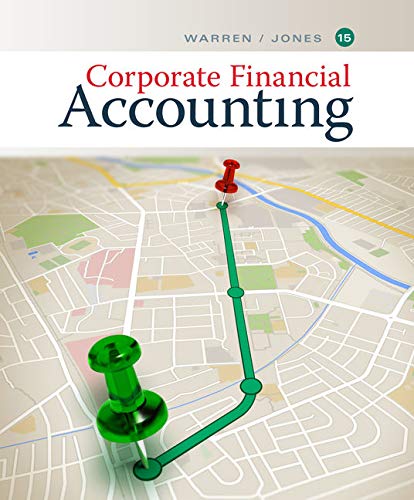
Stock investments: Stock investments are equity securities which claim ownership in the investee company and pay a dividend revenue to the investor company.
Fair value method: Fair value method is the accounting method used for accounting stock or equity investments which claim less than 20% of the outstanding stock of the investee company.
Debit and credit rules:
- Debit an increase in asset account, increase in expense account, decrease in liability account, and decrease in
stockholders’ equity accounts. - Credit decrease in asset account, increase in revenue account, increase in liability account, and increase in stockholders’ equity accounts.
To journalize: The stock investment transactions under the fair value method
Explanation of Solution
Prepare journal entry for the purchase of 4,000 shares of Company A at $50 price per share and a brokerage of $400.
| Date | Account Titles and Explanations | Post. Ref. | Debit ($) | Credit ($) | |
| September | 12 | Investments–Company A Stock | 200,400 | ||
| Cash | 200,400 | ||||
| (To record purchase of shares of Company A for cash) | |||||
Table (1)
Description:
- Investments–Company A Stock is an asset account. Since stock investments are purchased, asset value increased, and an increase in asset is debited.
- Cash is an asset account. Since cash is paid, asset account decreased, and a decrease in asset is credited.
Working Notes:
Compute amount of cash paid to purchase Company A’s stock.
Prepare journal entry for the dividend received from Company A for 4,000 shares.
| Date | Account Titles and Explanations | Post. Ref. | Debit ($) | Credit ($) | |
| October | 15 | Cash | 2,400 | ||
| Dividend Revenue | 2,400 | ||||
| (To record receipt of dividend revenue) | |||||
Table (2)
Description:
- Cash is an asset account. Since cash is received, asset account increased, and an increase in asset is debited.
- Dividend Revenue is a revenue account. Since revenues increase equity, equity value is increased, and an increase in equity is credited.
Working Notes:
Compute amount of dividend received on Company A’s stock.
Prepare journal entry for sale of 3,000 shares of Company A at $40 per share, and a brokerage of $200.
| Date | Account Titles and Explanations | Post. Ref. | Debit ($) | Credit ($) | |
| November | 10 | Cash | 119,800 | ||
| Loss on Sale of Investments | 30,500 | ||||
| Investments–Company A Stock | 150,300 | ||||
| (To record sale of shares) | |||||
Table (3)
Description:
- Cash is an asset account. Since cash is received, asset account increased, and an increase in asset is debited.
- Loss on Sale of Investments is an expense account. Since losses and expenses decrease equity, equity value is decreased, and a decrease in equity is debited.
- Investments–Company A Stock is an asset account. Since stock investments are sold, asset value decreased, and a decrease in asset is credited.
Working Notes:
Calculate the realized gain (loss) on sale of stock.
Step 1: Compute cash received from sale proceeds.
Step 2: Compute cost of stock investment sold Refer to Table (1) for value of cost of 4,000 shares.
Step 3: Compute realized gain (loss) on sale of stock.
Note: Refer to Steps 1 and 2 for value and computation of cash received and cost of stock investment sold.
Want to see more full solutions like this?
Chapter D Solutions
Cengagenowv2, 1 Term Printed Access Card For Warren/jones’ Corporate Financial Accounting, 15th
- Hello tutor please given General accounting question answer do fast and properly explain all answerarrow_forwardOn March 1, 20X1, your company,which uses Units-of-Production (UOP) Depreciation, purchases a machine for $300,000.arrow_forwardPlease provide the accurate answer to this general accounting problem using valid techniques.arrow_forward
- Can you explain the correct methodology to solve this general accounting problem?arrow_forwardPlease explain the solution to this general accounting problem with accurate principles.arrow_forwardI am searching for the correct answer to this general accounting problem with proper accounting rules.arrow_forward
 College Accounting, Chapters 1-27AccountingISBN:9781337794756Author:HEINTZ, James A.Publisher:Cengage Learning,
College Accounting, Chapters 1-27AccountingISBN:9781337794756Author:HEINTZ, James A.Publisher:Cengage Learning, Accounting (Text Only)AccountingISBN:9781285743615Author:Carl Warren, James M. Reeve, Jonathan DuchacPublisher:Cengage Learning
Accounting (Text Only)AccountingISBN:9781285743615Author:Carl Warren, James M. Reeve, Jonathan DuchacPublisher:Cengage Learning College Accounting, Chapters 1-27 (New in Account...AccountingISBN:9781305666160Author:James A. Heintz, Robert W. ParryPublisher:Cengage Learning
College Accounting, Chapters 1-27 (New in Account...AccountingISBN:9781305666160Author:James A. Heintz, Robert W. ParryPublisher:Cengage Learning Corporate Financial AccountingAccountingISBN:9781305653535Author:Carl Warren, James M. Reeve, Jonathan DuchacPublisher:Cengage Learning
Corporate Financial AccountingAccountingISBN:9781305653535Author:Carl Warren, James M. Reeve, Jonathan DuchacPublisher:Cengage Learning Financial Accounting: The Impact on Decision Make...AccountingISBN:9781305654174Author:Gary A. Porter, Curtis L. NortonPublisher:Cengage Learning
Financial Accounting: The Impact on Decision Make...AccountingISBN:9781305654174Author:Gary A. Porter, Curtis L. NortonPublisher:Cengage Learning





